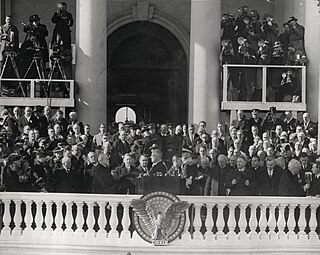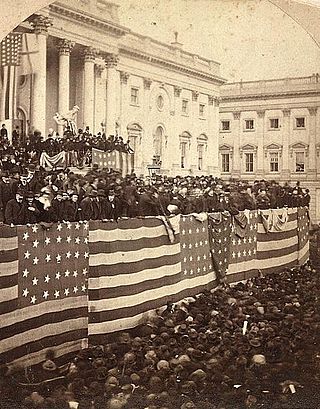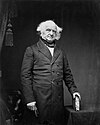
Martin Van Buren was an American lawyer, diplomat, and statesman of New York Dutch descent who served as the eighth president of the United States from 1837 to 1841. A primary founder of the Democratic Party, he served as New York's attorney general, U.S. senator, then briefly as the ninth governor of New York before joining Andrew Jackson's administration as the tenth United States secretary of state, minister to Great Britain, and ultimately the eighth vice president when named Jackson's running mate for the 1832 election. Van Buren won the presidency in 1836, lost re-election in 1840, and failed to win the Democratic nomination in 1844. Later in his life, Van Buren emerged as an elder statesman and an important anti-slavery leader who led the Free Soil Party ticket in the 1848 presidential election.

The 1836 United States presidential election was the 13th quadrennial presidential election, held from Thursday, November 3 to Wednesday, December 7, 1836. In the third consecutive election victory for the Democratic Party, incumbent Vice President Martin Van Buren defeated four candidates fielded by the nascent Whig Party.

Between 73 and 79 days after the presidential election, the president-elect of the United States is inaugurated as president by taking the presidential oath of office. The inauguration takes place for each new presidential term, even if the president is continuing in office for a second term.

The presidency of Martin Van Buren began on March 4, 1837, when Martin Van Buren was inaugurated as President of the United States, and ended on March 4, 1841. Van Buren, the incumbent vice president and chosen successor of President Andrew Jackson, took office as the eighth United States president after defeating multiple Whig Party candidates in the 1836 presidential election. A member of the Democratic Party, Van Buren's presidency ended following his defeat by Whig candidate William Henry Harrison in the 1840 presidential election.

The first inauguration of Andrew Jackson as the seventh president of the United States was held on Wednesday, March 4, 1829, at the United States Capitol in Washington, D.C. The inauguration marked the commencement of the first four-year term of Andrew Jackson as president and the second term of John C. Calhoun as vice president. Chief Justice John Marshall administered the presidential oath of office. Calhoun resigned 3 years, 299 days into this term, and the office remained vacant for the balance of it.

The inauguration of William Henry Harrison as the ninth president of the United States was held on Thursday, March 4, 1841, at the East Portico of the United States Capitol in Washington, D.C. This was the 14th inauguration and marked the commencement of the only four-year term of both William Henry Harrison as president and John Tyler as vice president. The presidential oath of office was administered to Harrison by Chief Justice Roger B. Taney. Harrison died 31 days into his term, the first U.S. president to die in office and has the shortest presidential term in American history. Tyler then succeeded to the presidency, creating precedence which would be followed seven more times before it was officially regulated through the Twenty-fifth Amendment in 1967.

The first inauguration of Bill Clinton as the 42nd president of the United States was held on Wednesday, January 20, 1993, at the West Front of the United States Capitol in Washington, D.C. This was the 52nd inauguration and marked the commencement of the first term of Bill Clinton as president and Al Gore as vice president. At 46 years, 154 days of age at the time of his first inauguration, Clinton was the third-youngest person to become president, and the first from the Baby Boomer generation.

The second inauguration of Bill Clinton as president of the United States was held on Monday, January 20, 1997, at the West Front of the United States Capitol Building in Washington, D.C. This was the 53rd inauguration and marked the commencement of the second and final term of Bill Clinton as president and Al Gore as vice president. This was the last presidential inauguration to take place in the 20th century, the last in the 2nd millennium, and the first to be streamed live on the internet.

The inauguration of George H. W. Bush as the 41st president of the United States was held on Friday, January 20, 1989, at the West Front of the United States Capitol in Washington, D.C. This was the 51st inauguration and marked the commencement of the only term of both George H. W. Bush as president and Dan Quayle as vice president. Chief Justice William Rehnquist administered the presidential oath of office to Bush and Justice Sandra Day O'Connor administered the vice presidential oath of office to Quayle. Bush was the first sitting vice president to be inaugurated as president since Martin Van Buren in 1837 and the last World War II combat veteran. Bush composed his own prayer for the ceremony which he recited at the start of his inaugural address; the last president to do so was Dwight D. Eisenhower at his first inauguration in 1953.

The second inauguration of Lyndon B. Johnson as president of the United States was held on Wednesday, January 20, 1965, at the East Portico of the United States Capitol in Washington, D.C. This was the 45th inauguration and marked the second and only full term of Lyndon B. Johnson as president and the only term of Hubert Humphrey as vice president. Chief Justice Earl Warren administered the oath of office. Lady Bird Johnson founded the tradition of incoming first ladies participating in the ceremony by holding the sworn-in president's Bible. Vice President Humphrey was sworn-in by John W. McCormack, the speaker of the House of Representatives. This was the first inauguration when the president rode in a bulletproof limousine.

The first inauguration of Thomas Jefferson as the third president of the United States was held on Wednesday, March 4, 1801. The inauguration marked the commencement of the first four-year term of Thomas Jefferson as president and the only four-year term of Aaron Burr as vice president. Jefferson was sworn in by Supreme Court Chief Justice John Marshall.

The third inauguration of Franklin D. Roosevelt as president of the United States was held on Monday, January 20, 1941, at the East Portico of the United States Capitol in Washington, D.C. This was the 39th inauguration and marked the commencement of the third, and eventually final full term of Franklin D. Roosevelt as president and the only term of Henry A. Wallace as vice president. This was the first and only time a president has been inaugurated for a third term; after the Twenty-second Amendment to the United States Constitution was ratified in 1951, no person can be elected president more than twice.

The inauguration of William Howard Taft as the 27th president of the United States was held on Thursday, March 4, 1909, at the Senate chamber inside the United States Capitol, Washington, D.C., instead of the regular East Portico due to blizzard. This was the 31st inauguration and marked the commencement of William Howard Taft's only term as president and James S. Sherman's only term as vice president.

The second inauguration of Andrew Jackson as president of the United States took place in the House Chamber of the U.S. Capitol on Monday, March 4, 1833. The inauguration marked the commencement of the second four-year term of Andrew Jackson as president and the only four-year term of Martin Van Buren as vice president.

The inauguration of Rutherford B. Hayes as the 19th president of the United States took place publicly on Monday, March 5, 1877, at the East Portico of the United States Capitol in Washington, D.C. This was the 23rd inauguration and marked the commencement of the only four-year term of Rutherford B. Hayes as president and William A. Wheeler as vice president.

The first inauguration of Ulysses S. Grant as the 18th president of the United States took place on March 4, 1869, at the East Portico of the United States Capitol in Washington, D.C. This was the 21st inauguration and marked the commencement of the first four-year term of Ulysses S. Grant as president and the only term of Schuyler Colfax as vice president. Chief Justice Salmon P. Chase administered the presidential oath of office. Outgoing president Andrew Johnson did not attend the inaugural ceremonies, as he and Grant refused to sit with each other in the carriage going to them. Johnson also refused to go in a separate carriage. Instead, he was in the White House signing last-minute legislation. This was the fourth time an outgoing president boycotted his elected successor's inauguration, an event that would not occur again until Donald Trump boycotted Joe Biden's inauguration in 2021 after failing to overturn the results.

The inauguration of Warren G. Harding as the 29th president of the United States was held on Friday, March 4, 1921, at the East Portico of the United States Capitol in Washington, D.C. This was the 34th inauguration and marked the commencement of Warren G. Harding's only term as president and of Calvin Coolidge's only term as vice president. Harding died 2 years, 151 days into this term, and Coolidge succeeded to the presidency.
The 1840 Democratic National Convention was held in Baltimore, Maryland, from May 5 to May 6. The Democratic Party re-nominated President Martin Van Buren by acclamation, but failed to select a nominee for vice president. Van Buren is the only major party presidential nominee since the ratification of the 12th Amendment to seek election without a running mate. Dragged down by the unpopularity of the Panic of 1837, Van Buren was defeated by the Whig Party's ticket in the 1840 presidential election.
The inauguration of Joseph Estrada as the thirteenth president of the Philippines took place on Tuesday, June 30, 1998, at the Barasoain Church in Malolos, Bulacan. The oath of office was administered by Chief Justice of the Supreme Court of the Philippines Andres Narvasa. Afterwards, Estrada delivered his inaugural speech at the Quirino Grandstand in Manila. The inauguration was held during the Centennial of Philippine Independence. The Inauguration was organized jointly by the Presidential Transition Cooperation Team of outgoing President Fidel V. Ramos and the Transition Team of incoming President Estrada.
In the United States, a contingent election is used to elect the president or vice president if no candidate receives a majority of the whole number of Electors appointed. A presidential contingent election is decided by a special vote of the United States House of Representatives, while a vice-presidential contingent election is decided by a vote of the United States Senate. During a contingent election in the House, each state delegation votes en bloc to choose the president instead of representatives voting individually. Senators, by contrast, cast votes individually for vice president.



















